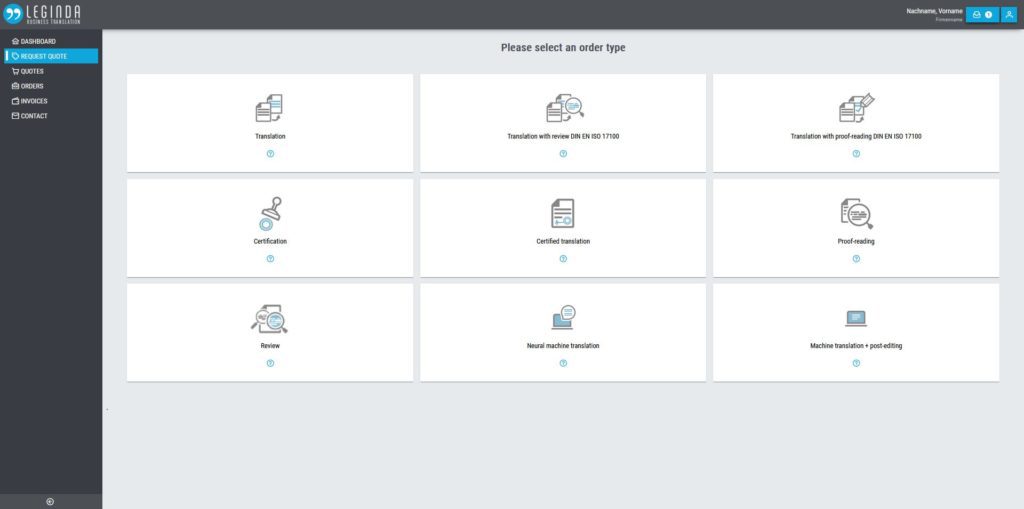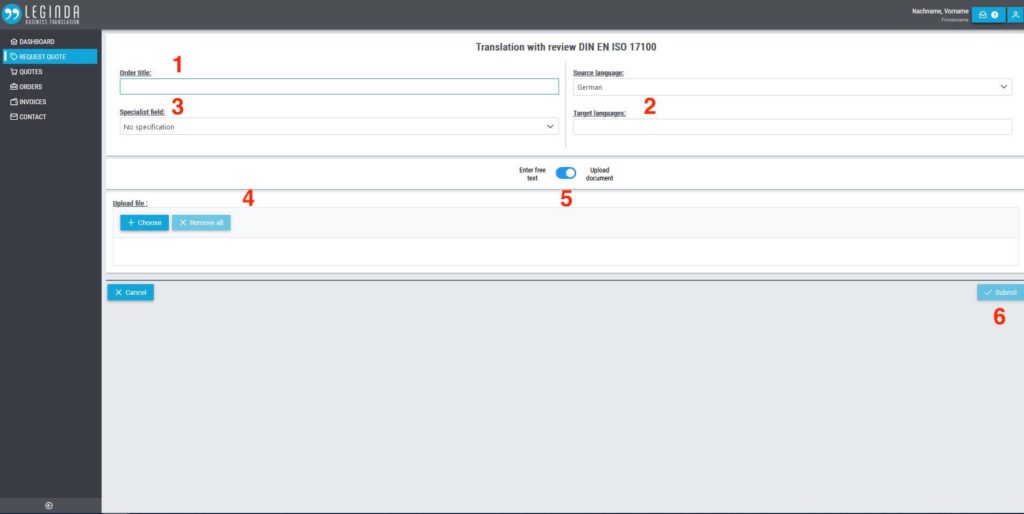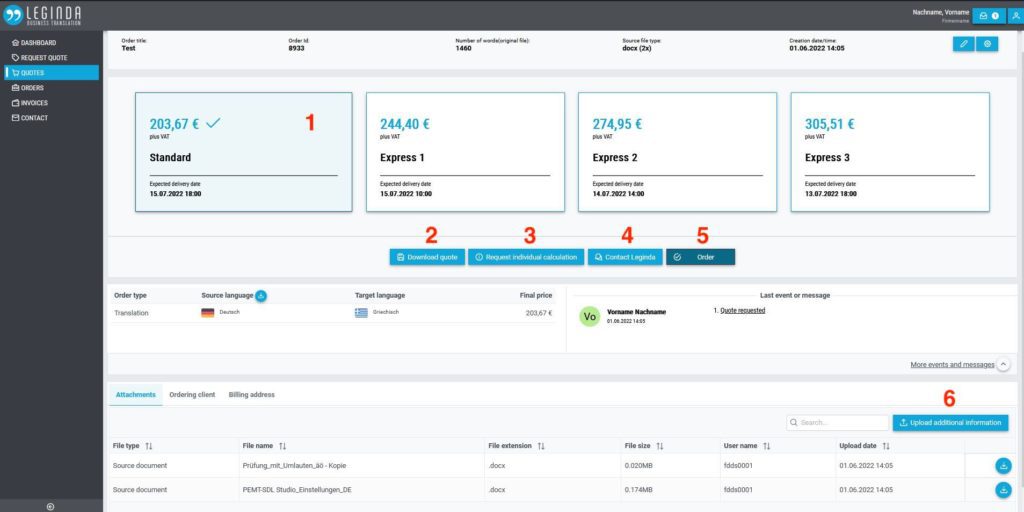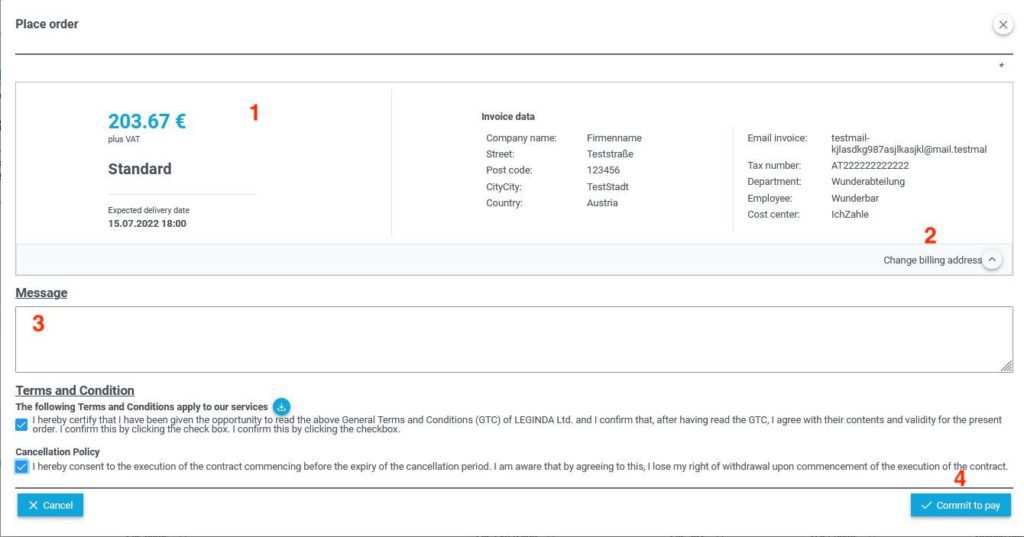Do you have a question?
We have the answers.
What languages can be translated with LEGINDA?
We offer translation services in over 40 languages, including English, French, Spanish, Italian, Russian, Chinese, Arabic, and many more. For a complete list of available languages, visit our translation portal.
How can I order a translation?
If you would like to order a translation, please register with the translation portal. Registration is free of charge. In the portal, you can immediately upload the file(s) to be translated and select the source and target language(s). If you have uploaded an editable file, the price is usually displayed immediately and you can order directly. However, you can also upload PDF files and request a quote. As soon as you have received the quote, you can order the translation directly via the portal. If you do not see a price immediately, you can always request a customized quote.
How much does a Leginda translation cost?
We distinguish between human translations, hybrid translations, and neural machine translations (NMT).
We offer neural machine translations at flat rates between €5 and €20, depending on the quantity.
Our prices for human translations start at €0.08 per word. The final price depends on the language combination, the subject area, and the urgency of the translation. Use our price calculator on the website or request a custom quote.
To calculate the total price for a translation, we need the text to be translated and information about the desired target language(s). We will then calculate a fixed price based on the number of words in the source text. With the help of a translation memory, discounts are calculated for repetitions and similar content. Depending on the purpose of the translation, we offer various delivery options that are subject to surcharges (e.g. translation with proofreading or with review). We offer express options for urgent translations..
To get the best prices, it is best to send us the text in an editable format.
Hybrid translations are machine-translated and then revised by post-editors. This results in cost savings of up to 50%.
What information do you need to prepare an offer?
In order to prepare a quote, we need the text that you want to be translated, preferably in an editable format. We also need information about the desired target language(s).
What kind of documents can be translated?
We translate a wide range of documents, including annual reports, contracts, technical manuals, websites, marketing materials, academic texts, and much more. Please contact us if you have any special requirements.
How long will it take for my translation to be completed?
The time required depends on the scope and complexity of the document. Smaller documents can be translated within 24 to 48 hours. Specifically, our standard delivery option is for 800 words per day for translation only, but we also offer express options for when it time is tight. You will receive an exact time frame once we have received the text to be translated.
How will I receive my translated documents?
The finished translations are delivered to you in the Leginda portal. When the project manager or controller delivers them, you will receive a notification by email. You can then log in to the portal and download your files.
How can I reduce or save on translation costs?
By placing orders more often. When you place your first order, we create a translation memory in which translation units are stored. These units are retrieved for subsequent orders, which has a positive effect on the price. Any existing translations can be used again, after being checked for context. They are then charged at a lower rate.
What text formats are suitable for translation?
We process all common file formats, such as files from the Office suite, Adobe, and many more. You can upload the following file formats to your account: ara, csv, dll, doc, docm, docx, dotm, dotx, gru, gsc, htm, html, idml, inx, itd, jpeg, jpg, mif, odp, odt, pdf, po, pot, potm, potx, pps, ppsm, ppsx, ppt, pptm, pptx, properties, rar, rc, sdlppx, sdlrpx, sgm, sgml, tag, ttg, ttx, txt, xlf, xls, xlsm, xlsx, xlt, xltx, xml, xtg, zip. If you have content in any other file formats, please feel free to contact us.
Can I have a PDF file translated?
We translate content in all common formats, including PDF format. We deliver files in editable format in their original form, so the formatting, images, etc. are retained. When we translate a PDF file, there are two options: Either the text is subsequently adapted to the original format by our DTP service, or we deliver the translation as plain text without further formatting. Additional costs apply for the DTP service. If you would like to use this option, please contact us.
How can I have a website translated?
There are various options for translating websites, depending on how the websites are built. With certain CRMs, you can often use plug-ins to export the content in various file formats such as XML or CSV and import it again in translated form (e.g. WordPress or TYPO3). Otherwise, there are also web spider tools that filter out the content, or you can copy the content manually and have it translated into different file formats.
How can I have a webshop translated?
Webshop software allows you to sell products and services via your own online shop. Having a translated version of your online shop and all of its content can help you be rated more highly by search engines, for example. Depending on the webshop system, there may be apps that allow you to export content (e.g. Shopify). You can provide us with the exported data in CSV or XML format for translation. As soon as the export files have been translated, you can import or integrate them into the webshop.
How is SEO taken into account in translations?
There are various strategies here: You can provide us with a ready-made keyword list with equivalents in the target languages, which we can incorporate into the translations of your texts using specific software and then review. Alternatively, we have the source-language keywords translated by our linguists and SEO specialists and checked based on the target market context, taking into account cultural nuances and the individual search habits of the target audience; or we can create the keyword lists for you in the source and target languages.
What are the options for translating videos?
One option is dubbing, also known as voice-over. The original audio in the video is either completely replaced by the target language audio (dubbing) or the target language audio is superimposed but the original audio track can still be heard quietly in the background (voice-over). However, both options are often simply referred to as voice-over. Another option is lip-sync dubbing. In this case, the audio is synchronized with the speaker in the video, and special requirements apply for the translation and production of the video. Subtitling is also an option for a video translation. The original audio is transcribed, translated, and incorporated or displayed in the video. The text is adapted for readability. There are different types of subtitles, including live subtitles or subtitles for the deaf and hard of hearing (SDH).
What is a style guide?
A style guide is a collection of rules and design guidelines focused on language and content. These guidelines address how a company communicates. The difference between style guides used in the translation process and editorial style guides is that they also include specific design guidelines for the target language, culture, and audience. They are used to transfer the style from the source language into the target language in line with the corporate philosophy as part of the translation process.
What does a translation agency actually do?
At Leginda, we coordinate all the steps required to produce a translation: from preparing the file and selecting a suitable translator to managing and using terminology and completing your order on schedule. We take care of communication with the translator, any queries, and any subsequent changes, regardless of whether the project is monolingual or multilingual.
What makes a good translator?
A good translator should, above all, be proficient in their own native language, and only translate into it. In addition, they should have a very good command of the source language(s) and be familiar with the source and the target culture. Of course, specialist knowledge and a certain level of computer proficiency are also essential.
What is the difference between an interpreter and a translator?
An interpreter translates orally, and a translator translates in writing. We provide translations of written texts as well as videos and subtitles.
What is the difference between proofreading and review?
Proofreading involves revising and correcting a translated text in terms of spelling, grammar, and terminology. In a review, the translation is checked against the original, and spelling, grammar, and terminology are also checked, and the style is adapted to match the original.
When do I need a certified translation?
A certified translation is always required if an official document is to be used in a state context, for example for public offices and authorities or in court. If the translation is to be used abroad, higher-level authentication (apostille) is required. We offer both options.
Why is terminology work so important?
Using terminology reduces misunderstandings and optimizes business communication. A defined terminology facilitates translation work and saves research time, which in turn saves time throughout the translation project. Standardized terminology reinforces a company’s image (corporate identity) and can promote branding.
How can I avoid costly and time-consuming corrections to translations?
By providing us with important reference materials and/or terminology in advance. If you have a style guide, glossary, or extensive terminology database, please feel free to send it to us so that it can be taken into account during the translation.
What are translation memories (CAT tools)?
CAT tool stands for computer-aided translation tool, which is not to be confused with machine translation. CAT tools are translation tools that help translators to translate large documents faster, at lower cost, and with consistent quality. These tools usually retain the formatting of the source text. Using these tools helps to ensure that translations are consistent and use the same terminology.
Is a machine translation a “Google translation”?
Not necessarily! “Google translation” is usually understood to mean machine translation using free tools. Google is one of the providers of neural machine translation, but there are other providers. MT providers now offer various options, such as paid cloud-based MT solutions, that ensure that customer data remain private. At Leginda, we do not use free machine translation tools. We have our own tool, which we combine with translation memory technology to achieve better and cheaper results for our clients.
Order process for translations
Log in to your account in our translation portal.
Are you not yet registered with us?
You are currently viewing a placeholder content from YouTube. To access the actual content, click the button below. Please note that doing so will share data with third-party providers.
More Information1. Request quote
Click “Request quote” in the menu and select the order type that you want to create a quote for.
2. Send text
Enter an appropriate title for the order. [1]
Please note that the title will appear on the invoice. You can adjust the title later.
Now select the source and the target language. [2]
Multiple target languages can be selected.
Optionally, you can select a subject area [3] from the list.
Next, [4], select the form in which the text to be translated will be transmitted. You can upload an existing document or ZIP file or enter a free text.
To do this, slide the toggle switch to the left for “Enter free text” or to the right for “Upload document(s).” [5]
When you are finished, click on “Submit”. [6]
3. Calculate price
To confirm the price and place a paid order, select the desired delivery option by clicking the corresponding box. [1]
The check mark always shows the currently selected option.
Under [2] you have the option of downloading the offer.
If no calculation is performed and you cannot see a price, click the “Request individual quote” button. [3]
You can also use this option if you require a faster delivery option. Our project managers will take care of this immediately and prepare an “individual quote,” which you will be notified of and which can be viewed in the portal.
You can write a message to our project managers by clicking the “Contact Leginda” button [4] . The message history remains documented for you in the “Processes and messages” tab.
To order, click “Order.” [5]
If you have any additional information in the form of files (glossary, sample translations, style guides, etc.), you can upload them under [6].
Under [7] you will find an overview of the number of words to be translated and other information.
4. Place order
Before the order can be placed, you will receive an overview of all order-specific information [1]: price, expected delivery date, and billing information.
If you wish to change the billing address or add a new address, you can use function [2] “Change billing address”.
Under [3] you have the option to add a personalized message and information to the order.
To place the order, click the button “Place paid order” after confirming the terms and conditions. [4]
The order process is now complete.
We will notify you by email when your order is ready.
2. Send text
Enter an appropriate title for the order. [1]
Please note that the title will appear on the invoice. You can adjust the title later.
Now select the source and the target language. [2]
Multiple target languages can be selected.
Optionally, you can select a subject area [3] from the list.
Next, [4], select the form in which the text to be translated will be transmitted. You can upload an existing document or ZIP file or enter a free text.
To do this, slide the toggle switch to the left for “Enter free text” or to the right for “Upload document(s).” [5]
When you are finished, click on “Submit”. [6]
3. Calculate price
To confirm the price and place a paid order, select the desired delivery option by clicking the corresponding box. [1]
The check mark always shows the currently selected option.
Under [2] you have the option of downloading the offer.
If no calculation is performed and you cannot see a price, click the “Request individual quote” button. [3]
You can also use this option if you require a faster delivery option. Our project managers will take care of this immediately and prepare an “individual quote,” which you will be notified of and which can be viewed in the portal.
You can write a message to our project managers by clicking the “Contact Leginda” button [4] . The message history remains documented for you in the “Processes and messages” tab.
To order, click “Order.” [5]
If you have any additional information in the form of files (glossary, sample translations, style guides, etc.), you can upload them under [6].
Under [7] you will find an overview of the number of words to be translated and other information.
4. Place order
Before the order can be placed, you will receive an overview of all order-specific information [1]: price, expected delivery date, and billing information.
If you wish to change the billing address or add a new address, you can use function [2] “Change billing address”.
Under [3] you have the option to add a personalized message and information to the order.
To place the order, click the button “Place paid order” after confirming the terms and conditions. [4]
The order process is now complete.
We will notify you by email when your order is ready.
Six delivery types to choose from—
customized to your needs!
Standard delivery
Delivery will be on a specific date depending on the amount of text at the best price. We process 150 words per hour, including a final check.
Express translation 1
You will receive the translation at a specific time. 182 words are processed per hour, including proofreading and final check. The surcharge for this is only 20%.
Express translation 2
With this delivery option, the processing time is drastically reduced and we also deliver by a fixed date and time, with a surcharge of 35%. For this option, no less than 245 words per hour are translated.
Express translation 3
This express translation is the fastest delivery option, with a processing rate of 322 words per hour, including final check.
Overnight express translation
For text volumes of up to 350 words and orders placed by 4 p.m., we can deliver the translation for most language pairs the very next morning, without charging an express surcharge! If you order earlier, the delivery quantity increases by 140 words per hour. For overnight express translations the express translation 3 price applies.
Individual request
For particularly urgent translations or very large volumes of text, we are also happy to arrange an individual fixed delivery date. To do this, please use the online system’s individual request function.
Standard delivery
Delivery will be on a specific date depending on the amount of text at the best price. We process 150 words per hour, including a final check.
Express translation 1
You will receive the translation at a specific time. 182 words are processed per hour, including proofreading and final check. The surcharge for this is only 20%.
Express translation 2
With this delivery option, the processing time is drastically reduced and we also deliver by a fixed date and time, with a surcharge of 35%. For this option, no less than 245 words per hour are translated.
Express translation 3
This express translation is the fastest delivery option, with a processing rate of 322 words per hour, including final check.
Overnight express translation
For text volumes of up to 350 words and orders placed by 4 p.m., we can deliver the translation for most language pairs the very next morning, without charging an express surcharge! If you order earlier, the delivery quantity increases by 140 words per hour. For overnight express translations the express translation 3 price applies.
Individual request
For particularly urgent translations or very large volumes of text, we are also happy to arrange an individual fixed delivery date. To do this, please use the online system’s individual request function.
We care about data protection
Because the security of your data is important to us!
Data protection
As a translation service provider, the three most important factors for the protection of our customer data are:
- Secure data transmission and storage: LEGINDA uses SSL-encrypted connections for transmitting sensitive data and stores it on secure servers to prevent unauthorized access.
- Confidentiality and secrecy: All employees and translators are contractually bound to secrecy to ensure the confidentiality of customer texts.
- Compliance with legal regulations: LEGINDA ensures that all data processing procedures comply with applicable data protection laws, in particular the GDPR, to ensure maximum security and compliance.
Data protection
As a translation
- Secure data transmission and storage: LEGINDA uses SSL-encrypted connections for transmitting sensitive data and stores it on secure servers to prevent unauthorized access.
- Confidentiality and secrecy: All employees and translators are contractually bound to secrecy to ensure the confidentiality of customer texts.
- Compliance with legal regulations: LEGINDA ensures that all data processing procedures comply with applicable data protection laws, in particular the GDPR, to ensure maximum security and compliance.




